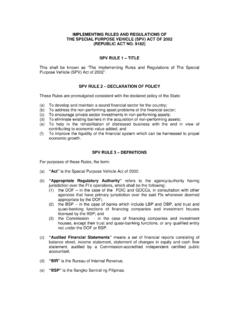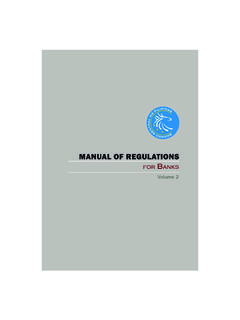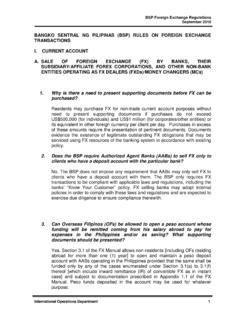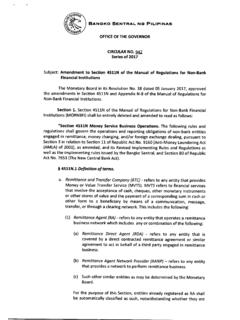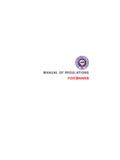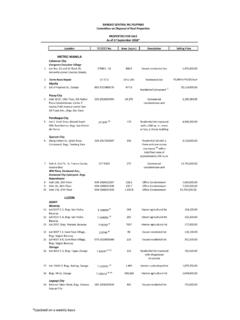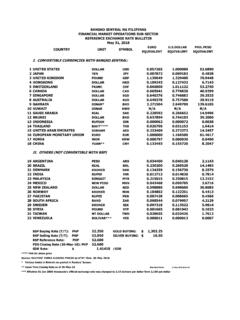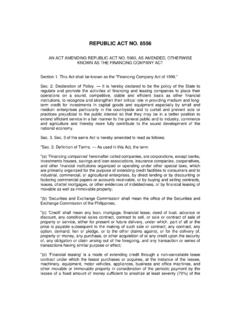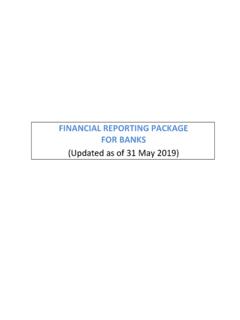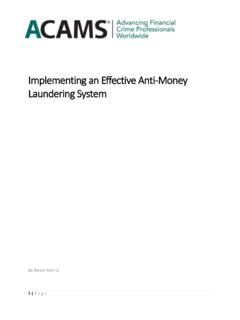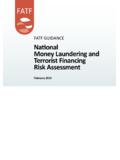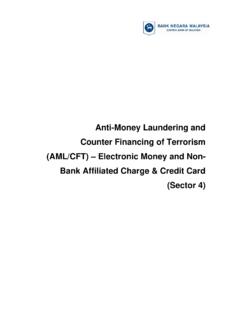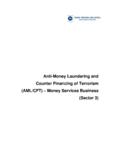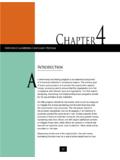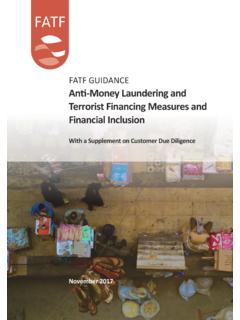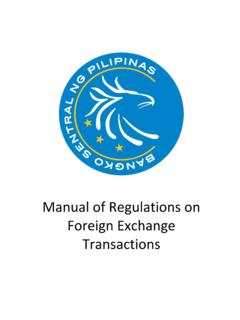Transcription of FREQUENTLY ASKED QUESTIONS RELATIVE TO THE …
1 FREQUENTLY ASKED QUESTIONS RELATIVE TO THE memorandum TO ALL PAWNSHOPS ON anti - money laundering 1) What is money laundering ? money laundering is an act or series or combination of acts whereby proceeds of an unlawful activity, whether in cash, property or other assets, are converted, concealed or disguised to make them appear to have originated from legitimate sources. One way of laundering money is through the financial system. Republic Act No. 9160, otherwise known as the anti - money laundering Act of 2001 (AMLA), as amended, defined money laundering as a scheme whereby proceeds of an unlawful activity are transacted or attempted to be transacted, thereby making them appear to have originated from legitimate sources.
2 2) What has the Philippine government done to curb money laundering ? The government enacted Republic Act ( ) No. 9160 (The anti - money laundering Act of 2001), which took effect on 17 October 2001. Certain provisions of AMLA were amended by No. 9194 (An Act Amending 9160) effective 23 March 2003. It has also issued the Revised Implementing Rules and Regulations (RIRR) implementing No. 9160, as amended. 3) What are considered unlawful activities under the AMLA, as amended? There are 14 unlawful activities or predicate crimes covered by the AMLA. These are, in the order enumerated in the law: Kidnapping for ransom Drug offenses Graft and corrupt practices Plunder Robbery and extortion Jueteng and masiao Piracy on the high seas Qualified theft Swindling Smuggling Electronic Commerce crimes Hijacking, destructive arson and murder, including those perpetrated against non-combatant persons (terrorist acts) Securities fraud Felonies or offenses of a similar nature punishable under penal laws of other countries 4) How is money laundered through the financial system?
3 Placement involves initial placement or introduction of the illegal funds into the financial system. Financial institutions are usually used at this point. Layering involves a series of financial transactions during which the dirty money is passed through a series of procedures, putting layer upon layer of persons and financial activities into the laundering process. Ex. wire transfers, use of shell corporations, etc. Page 2 of 2 Integration the money is once again made available to the criminal with the occupational and geographic origin obscured or concealed. The laundered funds are now integrated back into the legitimate economy through the purchase of properties, businesses and other investments.
4 5) Why is money laundering a problem? money laundering allows criminals to preserve and enjoy the proceeds of their crimes, thus providing them with the incentives and the means to continue their illegal activities. At the same time, it provides them the opportunity to appear in public like legitimate entrepreneurs. Organized crime, through money laundering , is known to have the capacity to destabilize governments and undermine their financial systems. It is thus a threat to national security. 6) What are the salient features of the law? It criminalizes money laundering , meaning it makes money laundering a crime, and provides penalties for its commission, including hefty fines and imprisonment.
5 It states clearly the determination of the government to prevent the Philippines from becoming a haven for money laundering , while ensuring to preserve the integrity and confidentiality of good bank accounts. It creates an anti - money laundering Council (AMLC) that is tasked to oversee the implementation of the law and to act as a financial intelligence unit to receive and analyze covered and suspicious transaction reports. It establishes the rules and the administration process for the prevention, detection and prosecution of money laundering activities. It relaxes the bank deposit secrecy laws authorizing the AMLC and the Bangko Sentral ng Pilipinas access to deposit and investment accounts in specific circumstances.
6 It requires covered institutions to report covered and suspicious transactions and to cooperate with the government in prosecuting offenders. It also requires them to know their customers and to safely keep all records of their transactions. It carries provisions to protect innocent parties by providing penalties for causing the disclosure to the public of confidential information contained in the covered and suspicious transactions. It establishes procedures for international cooperation and assistance in the apprehension and prosecution of money laundering suspects. 7) What is the anti - money laundering Council (AMLC)?
7 What are its powers? The AMLC is the Philippines financial intelligence unit, which is tasked to implement the AMLA. It is composed of the Governor of the Bangko Sentral ng Pilipinas (BSP) as Chairman & the Commissioner of the Insurance Commission (IC) and the Chairman of the Securities and Exchange Commission (SEC) as members. The AMLC is authorized to: Require and receive covered or suspicious transaction reports from covered institutions. Page 3 of 3 Issue orders to determine the true identity of the owner of any monetary instrument or property that is the subject of a covered or suspicious transaction report, and to request the assistance of a foreign country if the Council believes it is necessary.
8 Institute civil forfeiture and all other remedial proceedings through the Office of the Solicitor General. Cause the filing of complaints with the Department of Justice or the Ombudsman for the prosecution of money laundering offenses. Investigate suspicious transactions, covered transactions deemed suspicious, money laundering activities and other violations of the AMLA. Secure the order of the Court of Appeals to freeze any monetary instrument or property alleged to be the proceeds of unlawful activity. Implement such measures as may be necessary and justified to counteract money laundering .
9 Receive and take action on any request from foreign countries for assistance in their own anti - money laundering operations. Develop educational programs to make the public aware of the pernicious effects of money laundering and how they can participate in bringing the offenders to the fold of the law. Enlist the assistance of any branch of government for the prevention, detection and investigation of money laundering offenses and the prosecution of offenders. In this connection, the AMLC can require intelligence agencies of the government to divulge any information that will facilitate the work of the Council in going after money launderers.
10 Impose administrative sanctions on those who violate the law, and the rules, regulations, orders and resolutions issued in connection with the enforcement of the law. 8) What are the covered institutions? Banks, offshore banking units, quasi-banks, trust entities, non-stock savings and loan associations, pawnshops, and all other institutions, including their subsidiaries and affiliates supervised and/or regulated by the Bangko Sentral ng Pilipinas (BSP) Insurance companies, holding companies and all other institutions supervised or regulated by the Insurance Commission (IC)
